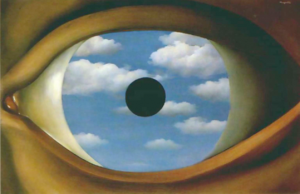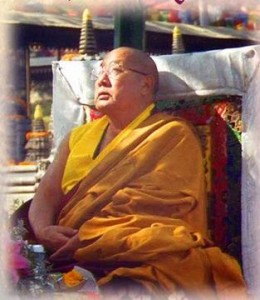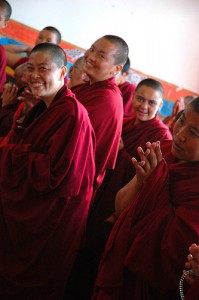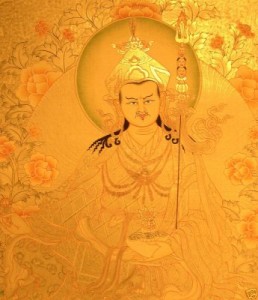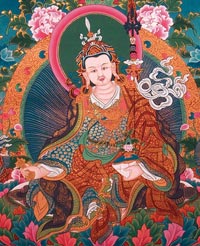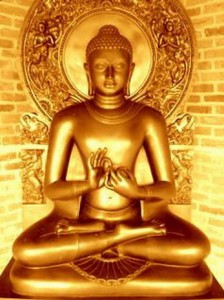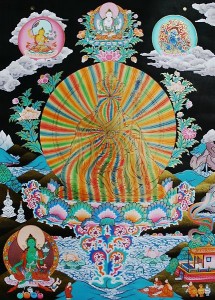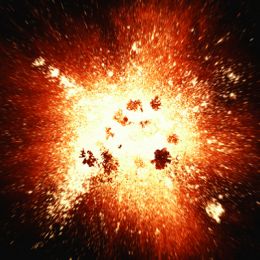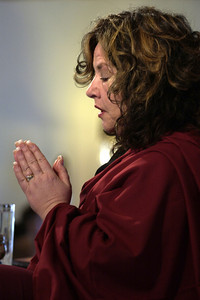
A teaching by Jetsunma Ahkon Lhamo given in the wake of the Tsunami in 2004
In order to pray, first we have to understand that we are Uncontrived Primordial View – Suchness. The Uncontrived Primordial View is every potential in its essential uncontrived form. Our nature is that which is unborn, absolutely complete and perfect in every detail. It isn’t made, it isn’t grown, and it can’t become stronger or weaker. It is conditionless. So we practice VIEW to allow the “boxes” of our mind to fall away so we can recognize that conditionless state and awaken to it, at last. Our prayers have to be like this as well.
Because we haven’t really awakened to that conditionless state yet and we are unable to disentangle or to let the boxes down so that our view opens and we are in a state of recognition, then we should rely on the Three Precious Jewels of Refuge. Sincerely take Refuge deeply in the most profound way that you can. Rely completely and unwaveringly on the Three Precious Jewels and the Lama who embodies all three.
How do we do this? First we have to get connected – wired up. The way we get wired up and connected is to practice Refuge. Realize we are in this dream state and so we rely completely on the Awakened One. Take Refuge Deeply.
In order to really pray we must let go of pride, our clinging to self. The one that says, “Look at me, I’m praying. Maybe if I recite this mantra, it will go over there to that person.” That’s not very awakened, is it? Rather, this is dualistic. The most important element in learning to pray is to let go of pride, the idea that I am a practitioner, I am praying, I am doing this, I must be good at it. Me, Me, I, I.
Our pridefulness and doubt are the two main obstacles to true prayer. Haughtiness and pride lead to anger. Pride precedes anger because you think you are right.
With prideful thoughts, we are clinging to self-nature as being inherently real and we are always in a state of judgment. If we are high, others are low. Develop awareness that we are the same nature. All of us are expressions of the infinite possibility of the Primordial Uncontrived Wisdom State…. Like white light going into a crystal and the colors are all broken up into different shades and beautiful reflections.
So instead of pridefulness when we get ready to pray, we should get down on our knees and pray and say: “These are my brothers and sisters, some of them swept off the face of the earth by this giant wave, some of them are hungry, they’ve lost their families, many of them are in the bardo….” So we think with that kind of compassion and consider the situation of other sentient beings rather than worrying so much about ourselves. Simply consider their suffering. Keep one’s ears open to their calls, to their suffering and to recognize that they are the same. Not higher, not lower…. the same. They are the same in their Nature.
Adopt the posture of a “clear hearing” of the calls of sentient beings. “I hear you. I am not separate from you”. We have to hear the cries of sentient beings and then remember they are the same as us. Have the posture of “It is a privilege to honor that which you are”.
Untangle your pride. Its like a constricting force on your heart. It keeps you from opening up. It keeps you separate. It keeps you miserable and it affirms samsara every day. You are praying for suffering when you pray with pridefulness. Lose the prideful stance and connect, wire-up to the Three Precious Jewels. Pridefulness is the opposite of prayer.
“So, as we realize that others need our help and we begin to heed their call, we turn to what is real, what is profound. From the Great Void…. from the absolute uncontrived undifferentiated spontaneously complete emptiness, is the brilliance of the Great Bodhicitta. The Great Bodhicitta is the first movement, like the first word, the first movement. It’s the arising of the Buddha Nature in a gossamer seemingly phenomenal form. The Bodhicitta, the first movement of emptiness contains all potential…the Big YES. Separate from nothing, containing all potential, containing all accomplishment…the Great Bodhicitta is the first movement of the Absolute, and that is also called Compassion.”
Compassion is your nature. You have deprived yourself of the deliciousness, the comfort and the happiness of true compassion, of the Bodhicitta for so long that the Bodhicitta seems to you like something you have to work on, like an outsider that you have to bring into your home. How sad. Because it is your nature.
How do we develop the unconstricted, uncontrived view? First we practice Guru Yoga. Guru Yoga is the nest in which prayers are developed. In Guru Yoga we see the Lama as the embodiment of all the fields of refuge, all of the excellent extraordinary displays of Buddha nature that did not arise in samsara, that are pure and untainted. Through your practice, you become absolutely non-dual with the Guru. You mix your mind stream with the Guru like milk with water.
Train yourself to remember to receive the Three Light Empowerment of body, speech and mind 24 hours a day. Receive the nectar, the blessing every minute of every day. Receive this amazing phenomena of connection. Develop the habit of constantly keeping that connection. This is prayer without ceasing. When we receive that empowerment, our mind is mixed with the Guru and the blessings are all-present. Mix your mind with the Guru’s mind. Awaken to the non-duality. The Nature that is your Nature.
We have to be willing to change. It takes getting down on our knees and challenging our habitual tendencies. Dharma cuts like a knife. It’s supposed to. It’s doing a big job. We have to do a lot of work because most of our life we spend chanting, “Om samsara Hung.” So we look to the teacher, we look to the Buddha, we look to the Dharma, and we look to the sangha with determination and strength. It takes steadfast Vajra Courage.
Prayer is when you are in a state of awakening; when the Bodhicitta that is the nectar of the Guru’s mind is mixed with your own mind, and the nectar becomes inseparable. That nectar is the Bodhicitta. It is being fully aware that your nature is the Bodhicitta and it is the Bodhicitta that benefits sentient beings. When you are aware that you are that, it is that that you send to others. Being confident, not prideful, confident in that blessing; and therefore you can pray. Now you have the Bodhicitta. Now you ARE the Bodhicitta. And that is the potency and power that you rely on.
It’s every minute. It’s a path. It’s a way of life. And it is the true method to achieve the precious awakening. When you know that other beings are suffering so terribly and we have found this “Jewel” and it is in our hands, and this nectar is given freely, then I ask you “Why not learn to pray?”
© Jetsunma Ahkön Lhamo
